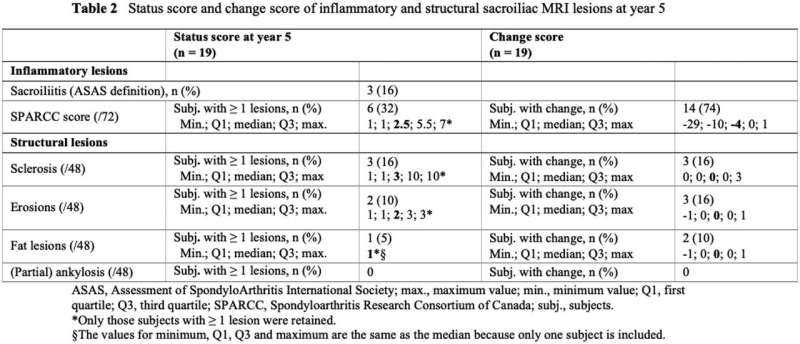This article has been reviewed according to Science X's editorial process and policies. Editors have highlighted the following attributes while ensuring the content's credibility:
fact-checked
proofread
Does bone marrow edema induced by mechanical stress progress to structural lesions?

Immediately after childbirth, a large number of women have sacroiliac bone marrow edema (BMO) visible on MRI. Although generally attributed to mechanical stress, these transient postpartum lesions bear a striking resemblance to the inflammatory lesions seen in axial spondyloarthritis (axSpA).
BMO in the sacroiliac joint on MRI is present in up to 84% of people with non-radiographic axSpA—but it is also often seen in a non-inflammatory setting, such as in women after childbirth. As back pain is common after childbirth, differential diagnosis with axSpA is an important issue in clinical practice.
In axSpA, active inflammatory lesions are likely to progress to structural lesions over time—particularly fat lesions and erosions. But it is not known whether the same is true for BMO induced by mechanical stress. In June 2024, EULAR—The European Alliance of Associations for Rheumatology—held its annual congress in Vienna, Austria.
In a clinical abstract session on imaging aspects of spondyloarthritis, new data were presented on the long-term evolution of postpartum BMO, and the potential development of structural lesions.
The researchers used follow-up data from a prospective study examining sacroiliac MRI lesions in healthy women following an uncomplicated vaginal delivery. Just over half of the original 35 participants underwent a new MRI of the sacroiliac joint approximately 5 years after initial inclusion.
Structural and inflammatory lesions were assessed using a method similar to the Spondyloarthritis Research Consortium of Canada (SPARCC) scoring system. Baseline images were re-evaluated together with the 5-year follow-up data.
Overall, low numbers of fat lesions, erosions, and sclerosis were observed at both baseline and in the 5-year MRI images, whereas no ankylosis was accounted for. Fat metaplasia and erosions did not change significantly between baseline and 5-year follow-up. Sclerosis increased in only 3 of the 19 participants, all of whom had BMO after delivery.
As expected, there was a significant decrease in BMO from baseline, although 32% of women still had BMO at the 5-year follow-up—half of whom met the ASAS definition of sacroiliitis. Having another delivery during the follow-up period did not seem to affect the presence of BMO at follow-up.
These results show that there is no significant development of structural MRI lesions in women 5 years after delivery—but BMO remained prevalent. This supports the hypothesis that transient mechanical stress-induced sacroiliac BMO on MRI does not seem to evolve into structural lesions—at least over the first 5 years.
More information: L. De Meester et al, OP0222 Sacroiliac bone marrow oedema on postpartum MRI does not develop into structural lesions over a 5-year follow-up period, Scientific Abstracts (2024). DOI: 10.1136/annrheumdis-2024-eular.6091


















